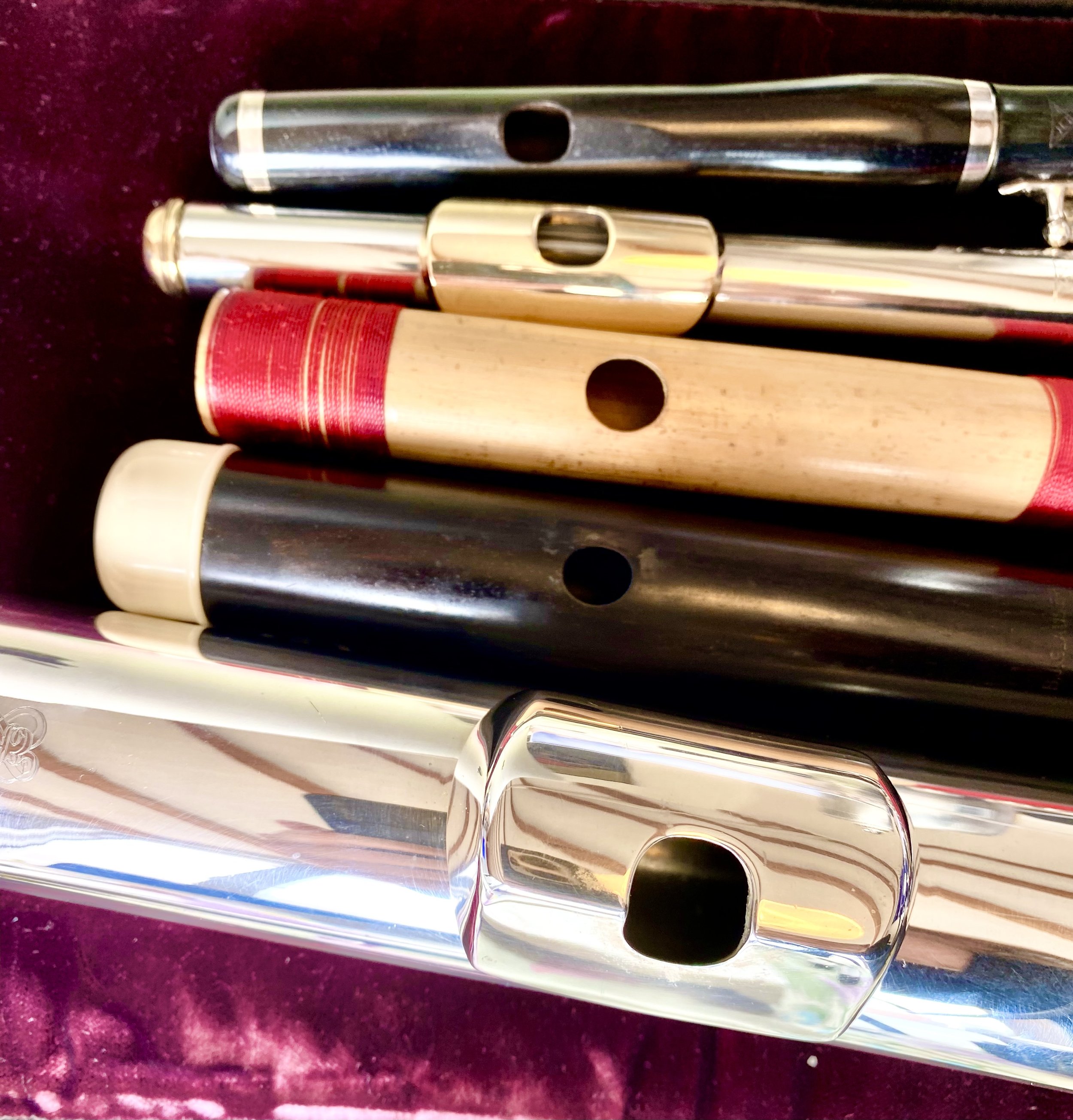Lately I’m keeping busy playing several different flutes “each in order, all together” as F.M. Alexander would say. This is a technical challenge, and naturally, one that I alone threw at myself…why stick with one flute when you can juggle FIVE?? The goal is to be able to pick any one of them up and play well straight off the bat. To go from contrabass to piccolo and back without dropping a beat, to turn from one to another “on a dime”.
(Apropos of multiple flutes, I am reminded of Rossini’s little ditty: “What’s worse than a flute? TWO flutes!” Nonetheless he wrote flute duets in every single opera, so I suspect he was just pleased with himself for coming up with a clever joke!)
Anyway, I have been staring down a small collection of flutes: a bansuri (Indian bamboo flute), a contrabass flute (four times the length of a concert flute), a piccolo (half the length), a baroque flute, and finally the “normal” concert flute.
Aside from their differing lengths, each has peculiarities of construction that requires adaptation—ideally instantaneously. At first, each one gently ask you to adjust, but in short order outright DEMANDS to be approached differently, else the result fall somewhere between questionable and perfectly dreadful!
This delightful little self-imposed challenge has invited me to explore my ability to adapt, which is to say to respond to a stimulus. Which is to say, to work on my Alexandrian technique. And in order to adapt, I must first be AVAILABLE to adapt. I must make the fundamental choice to be WILLING to adapt. In Portuguese the word for this willingness is “disponibilidade”; I put myself “ao dispor”—open to—adapting.
To clarify, the opposite would be to force the playing of every flute to conform to a single standard, to try to shove one flute into the “shoes”, so to speak, of another. Naturally, I have previously attempted this approach, which results in a squeaking piccolo, an overblown contrabass, a wooly-sounding baroque flute (hmmm, this one is particularly familiar…), and so forth. Nope, we cannot use the “ruler" of the concert flute to measure the others.
Instead, I use the principle of play and experimentation, exploring cause and effect like a scientist, removing—to the best of my ability—prejudices and pre-determined expectations.
The more I practice these (and other) flutes in this spirit, “asking them” how they would like to be played, the better the results.
[Deets for flutists: aside from the length of the flute, other variables include the cylindrical or conical construction of the tube, the size of the embouchure and tone holes, the height and shape of the embouchure wall, and the key system or lack thereof. All these affect the resistance, volume, color, and tuning, which affect the blowing, which affects everything…]
Immersed as I currently am in this back-and-forth experimentation, a sort of feedback-loop, it occurs to me that this spirit of disponibilidade applies to other aspecst of music-making as well, and to life in general. Being “available” for adaptation can be tremendously useful.
In any ensemble, it is handy to be able to “turn on a dime”, adjusting appropriately according to whether your part is the “solo” line, or a secondary or tertiary line. None works without the others, and—like bopping back and forth between disparate flutes—this adapting is one of the delights of ensemble playing. We push our part into the “spotlight”, then duck back into the color, or harmony. In Brahms symphonies, as far as I can tell, there is not a single uninteresting note or less-than-gorgeous line anywhere in the 25 or so orchestral parts. Ah, dear Brahms!! (It is perhaps a particular danger of the flute—top line of the score—to assume our part is always a solo!)
In life, too, it’s surely advantageous and pleasurable to similarly adapt to the demands of any situation. I’m the teacher: I run the show. I’m the student: I enjoy following someone else. I go to a lecture and sit quietly. In the break, I turn to the person next to me and a fascinating conversation ensues. We take turns switching from speaker to listener, and back. I speak to one friend with a specific level of energy, openness, and vocabulary, but with another friend—an entirely different person—I speak entirely differently. I mean, IDEALLY, I do this! (Lordy-me, I am soooo far from a master…)
In sum, we humans have the wits to become virtuosos of adaptation and disponibilidade, as long as we are tuned in!
So, metaphorically speaking, while of course we enjoy focussing on concert flute solos, in the long run, figuring out which “flute” a particular situation demands, what part we play in the whole, and adapting ourselves, can be tremendously fulfilling. There is so much richness and plain old fun in the switching around: being now the flighty star, now the hidden warmth of the harmony, now part of the propulsive rhythm section. Go for it: turn on a dime!
